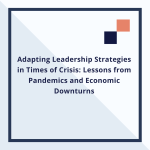In challenging times, when a company finds itself facing internal chaos, low morale, or external pressures, the role of an executive leader becomes more crucial than ever. A strong executive leader is not just someone who manages the business but someone who understands the pulse of the organization, actively working to transform the chaos into a thriving environment. In such times, leadership must combine strategic direction with motivational energy to revitalize the team and get the company back on track.
Table of contents [Show]
- Understanding the Chaos: Diagnosing the Issues
- Setting a Clear Vision: Guiding the Way Forward
- Leading by Example: Building Trust Through Action
- Empowering and Motivating the Team: The Power of Recognition
- Creating a Culture of Open Communication: Fostering Transparency
- Offering Support and Resources: Investing in Development
- Encouraging Innovation: Turning Crisis into Opportunity
- Conclusion: The Executive’s Role in Rebuilding
Understanding the Chaos: Diagnosing the Issues
Before taking any corrective action, an effective leader must first diagnose the problems plaguing the organization. Are the issues related to poor communication, lack of direction, a misaligned culture, or external market pressures? Gathering feedback from employees at all levels is crucial for understanding the root causes of the instability. A leader who listens deeply and assesses both the emotional and operational aspects of the turmoil can better frame the challenges and craft a targeted plan for recovery.
Setting a Clear Vision: Guiding the Way Forward
Once the issues are identified, the executive must set a clear, compelling vision that offers hope and direction. This vision is not just about financial targets or operational milestones but should include the cultural and emotional recovery of the team. In times of confusion, employees look to leadership for a sense of stability and purpose. A well-communicated vision rallies the team around a common goal, shifting focus away from the problems and towards future possibilities.
Leading by Example: Building Trust Through Action
Leadership in turbulent times requires more than just words—it requires actions that demonstrate commitment to improvement. Executives must lead by example, showing transparency, accountability, and resilience. Employees are more likely to respond positively when they see their leaders making tangible efforts to solve problems, being open about challenges, and taking responsibility where necessary. This builds trust and confidence, essential ingredients for restoring stability in any workplace.
Empowering and Motivating the Team: The Power of Recognition
In a disordered environment, employee morale often takes a hit, leading to decreased productivity and disengagement. An executive must focus on reigniting the team’s passion by fostering a culture of recognition and appreciation. Simple acts like acknowledging efforts, rewarding hard work, and celebrating small wins can make a significant impact on team spirit. This motivates employees to stay engaged and take ownership of their roles in helping the company recover.
Creating a Culture of Open Communication: Fostering Transparency
A vital part of fixing a struggling workplace is creating a culture where communication flows openly and transparently. Executive leaders should prioritize regular updates, town halls, and feedback sessions, ensuring employees feel heard and informed. This helps reduce anxiety in uncertain times, as employees are less likely to speculate about the company’s future when they are kept in the loop.
Offering Support and Resources: Investing in Development
No recovery is possible without investing in the people behind the company’s operations. An executive leader should provide the necessary resources, whether through training, career development opportunities, or mental health support. By demonstrating that the organization values its employees' growth and well-being, leaders can inspire a renewed sense of loyalty and motivation among the workforce.
Encouraging Innovation: Turning Crisis into Opportunity
In times of disruption, there is often opportunity for innovation. A great executive leader encourages creative thinking and problem-solving, empowering employees to propose new ideas and approaches. By fostering an environment where risk-taking is celebrated, leaders can channel the energy of the crisis into innovative solutions that may even propel the company forward.
Conclusion: The Executive’s Role in Rebuilding
Navigating a company through turbulent times is no small task, but with the right blend of clear vision, empathy, and action, executive leaders can inspire their teams to overcome the challenges. By creating a motivating environment built on trust, recognition, and open communication, leaders can transform a struggling workplace into a resilient, high-performing organization.






